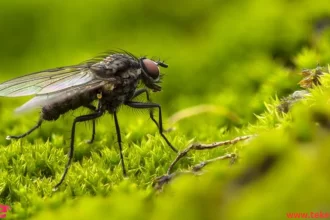The Nubian giraffe is a type of giraffe that was widespread throughout Northeast Africa and is now an endangered species. In this article on TekeTrek, we will discuss this type of giraffe, its diet, habitat, and lifestyle.

Characteristics of the Nubian Giraffe
- The kingdom Animalia, class Mammalia, and order The Nubian giraffe belongs to Artiodactyla, Nubian giraffe scientific name is Giraffa camelopardalis camelopardalis.
- It is part of the giraffe family. The Nubian giraffe is the tallest mammal in the world.
- Male Nubian giraffe height can reach a of 5.7 meters, with a neck length of 2.4 meters, and can weigh up to 2000 kilograms.
- Female Nubian giraffes are shorter by about 0.7 to 1 meter, and Nubian giraffe weight reaches 1180 kilograms.
- At birth, giraffe calves are 2 meters tall from the ground to the shoulders. Nubian giraffes have a spotted coat, and the pattern varies depending on the environment in which the giraffe lives.
- The spots on the Nubian giraffe’s coat can be small, medium, or large, with colors ranging from yellow to black.
- Nubian giraffes have long and strong legs, with their front legs being longer than the back ones. Their necks contain 7 elongated vertebrae.
- This type of giraffe has large eyes and a black tongue that is 45 cm long, a sharply sloping back from the shoulders to the rump, and thin, long tails ranging from 76 to 100 cm in length.
Nubian giraffe habitat
The original habitat of the Nubian giraffe is Africa, especially south of the Sahara Desert to East Transvaal, Natal, and northern Botswana. However, today these giraffes have disappeared from most parts of West Africa, except for the remaining population in Niger.
Nubian giraffes live in arid and dry lands, seeking areas enriched with the growth of acacia trees. Giraffes have been found in savannas, grasslands, or open forests. Since Nubian giraffes do not drink much water, they have been found far from water sources.

Reproduction of the Nubian Giraffe
- For the Nubian giraffe, pregnancy occurs during the rainy season, with births happening in the dry months.
- Their births occur from May to August. Female Nubian giraffes reproduce every 20 to 30 months, with a gestation period of about 457 days.
- Usually, female Nubian giraffes give birth to one calf, and while twins are rare, they do occur sometimes.
- Newborn calves stand on their feet and begin suckling within fifteen minutes of birth. The weaning period ranges from 12 to 16 months.
- The period of independence varies between female and male Nubian giraffes, with females tending to stay within the herd, while males seek solitude until they find their own herd.
- Nubian giraffe calves hide for most of the day and night. In their first week, the calf remains on the ground.
- The mother stays close, about 25 meters away, to guard her children and feed them. The female also returns at night to her calves to breastfeed them.
- After about three to four weeks, the mother Nubian giraffes guide their young to nursery groups.
- The nursery group allows the mother Nubian giraffes to roam away from the young calf. The mothers take turns watching all the young in the nursery group, but at night, all the mother giraffes return to nurse their young.
Lifespan of the Nubian Giraffe
The average expected lifespan of a Nubian giraffe is between 20 to 27 years in zoos. Giraffes live for 10 to 15 years in the wild.
Behavior of the Nubian Giraffe
- Giraffes are social animals, living in loose, open, and unstable herds ranging from 10 to 20 individuals. Although some herds have been observed to reach 70 individuals, individual giraffes join and leave the herd at will.
- Herds can include all females, all males, females with young calves, or be mixed in gender and age. Female Nubian giraffes are more social than males.
- Nubian giraffes feed and drink in the morning and evening, and rest at night while standing. When resting, the Nubian giraffe places its head on its back leg, forming an impressive arch with its neck.
- Nubian giraffes sleep standing up, but they can also lie down occasionally. During the hot midday period, giraffes usually chew their cud as ruminants.
- Nubian giraffes are fast-moving mammals, with speeds ranging from 32 to 60 kilometers per hour, and they can run for long distances.
Communication and Perception of the Nubian Giraffe
- The voice of the Nubian giraffe is rarely heard, and they are usually considered silent mammals. Giraffes communicate with each other through infrasound. Sometimes, Nubian giraffes talk to each other through hums or whistle-like screams. Other sounds of communication for giraffes include moaning, snoring, hissing, and flute-like sounds.
- The vision of the Nubian giraffe primarily depends on its height.
- Its height allows giraffes to maintain constant visual contact while being at a distance from their herd.
- The sharp vision of the Nubian giraffe can detect predators from a distance, allowing it to prepare to defend itself by kicking.
- Individuals within the herd may spread widely across the grasslands in search of good food or drink and only gather together at good food trees or in case of threat. (“Grzimek’s Animal Life Encyclopedia,” 2003)
Nubian Giraffe diet
Nubian giraffes are herbivores, feeding on leaves, flowers, seed pods, and fruits.
In areas where the savanna floor is salty or filled with minerals, they also eat the soil. Giraffes are ruminants with a four-chambered stomach. Chewing cud while traveling increases their feeding opportunities.
Nubian giraffe predators
- Lions are one of the most common predators of Nubian giraffes, in addition to cheetahs and hyenas.
- Adult giraffes are capable of defending themselves as they remain vigilant, able to run fast, and deliver deadly kicks with their front hooves.
- Crocodiles may also prey on them while they come to water wells to drink. Most predators target young, sick or old giraffes.


The most important frequently asked questions about the Nubian giraffe
- What is the average length of a Nubian giraffe?
The length of a Nubian giraffe can reach up to 6 meters.
- Is the length of the neck of a Nubian giraffe longer than its body?
No, if the giraffe is 5.7 meters tall, then its neck length is 6 meters.
- Where is the Nubian giraffe found?
The Nubian giraffe is native to Africa, especially sub-Saharan Africa to eastern Transvaal, Natal, and northern Botswana. But today these giraffes have disappeared from most parts of West Africa, except for what remains of them in Niger
- What is the age of the Nubian giraffe?
The average life expectancy of the Nubian giraffe is between 20 and 27 years in zoos.
Giraffes live for 10 to 15 years in the wild.
- How many times does a female Nubian giraffe give birth each time?
Female Nubian giraffes usually give birth to one calf, and the phenomenon of twins is not apparent, but it does happen sometimes
- What is the behavior of the Nubian giraffe?
Giraffes are social animals, living in loose, open, unstable herds of 10 to 20 individuals.
- How many Nubian giraffes are left?
There are 4,000 giraffes left in Africa.
- Are there giraffes in Sudan?
Yes, giraffes there in Sudan.


In conclusion, Nubian giraffes are an attraction in many zoos and wildlife parks. Unfortunately, giraffes have been killed for their meat and hides. The thick skin is turned into buckets, bridles, whips, and belt straps, and sometimes for musical instruments. We hope we have provided you with valuable and exciting information about the Nubian giraffe that you have enjoyed.






